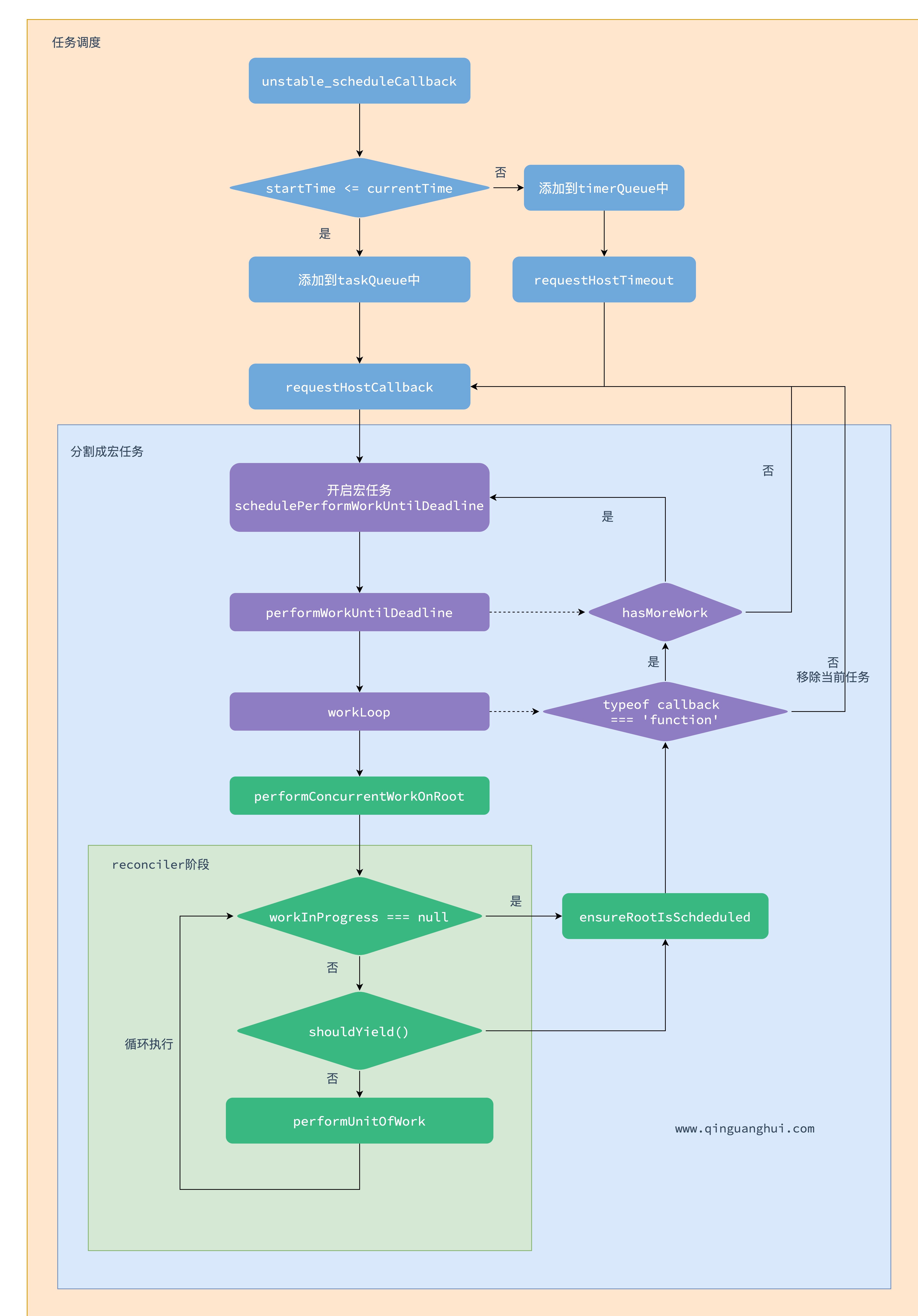任务调度 Scheduler
调度总流程

时间切片
在浏览器一帧章节里介绍到,在浏览器一帧里大致会有以下几个阶段:
一个task(宏任务) -> 队列中全部微任务 -> requestAnimationFrame -> 浏览器重排/重绘 -> requestIdleCallback
如果React的更新渲染层次比较深,渲染时间超过一帧(16.6ms)的时间,那么就会阻塞浏览器的重排/重绘。通常情况下,在100ms内用户感知不会很明显,但是超过这个值后就会感觉到卡顿。
在ConcurrentMode中,React通过时间切片的方法解决这一问题,通过将更新中的render阶段划分一个个的小任务,这个小任务指的是beginWork + completeWork两个阶段(fiber结构就是为了能方便的构建这些小任务),通常来说这些小任务连续执行的最长时间为5ms。
function workLoopConcurrent() {
// shouldYield 代表这个任务开启的时间 与 现在的时间 之间的间隔是否大于 定义的时间间隔。
// 比如执行超过了 5ms 那么此时 shouldYield() 就为true,需要暂停渲染。
while (workInProgress !== null && !shouldYield()) {
performUnitOfWork(workInProgress);
}
}简单例子
那么React是如何进行实现时间切片即任务最长连续执行时间为5ms的呢?以一个简单点的例子来讲:
<button id="btn" onclick="handle()">点击事件</button>
<script>
function handle() {
console.log('click 事件触发 ')
}
function performUnitOfWork() {
performUnitOfWork()
}
performUnitOfWork()
</script>在上面的代码中当点击按钮时,并不会触发事件。因为performUnitOfWork是同步循环执行,会导致完全没有时间执行其他任务,以及浏览器也不会进行重排重绘。这样handle的代码也就不会执行了。那么怎样才能使得handle中的代码有时间执行呢?在浏览器帧章节里提到,一次渲染中可以执行多次的宏任务,并且浏览器会自己来调节具体执行多少次,而且一般不会阻塞正常渲染。那么代码可以改写如下:
<button id="btn" onclick="handle()">点击事件</button>
<script>
function handle() {
console.log('click 事件触发 ')
}
function performUnitOfWork() {
setTimeout(performUnitOfWork)
}
performUnitOfWork()
</script>改写成这样后,click事件就能触发了,触发的顺序如下图所示:

这样就能在渲染任务中间穿插执行其他任务了,但是如何保证渲染任务中连续执行的小任务只执行5ms,并且保证留有足够的时间给浏览器执行其他任务和渲染呢?这就要使用到shouldYield()方法了。每次执行一个小任务时记录开始时间,下次执行的时候看与开始时间是否相隔超过5ms,如果没有超过继续执行下一个小任务,此时均为同步执行。如果超过5ms就跳出当前任务,并设置一个宏任务开始下一轮事件循环。这样它们之间就留有充足的时间执行其他任务了。
scheduleCallback
调度的过程通过Scheduler包实现。在ensureRootIsScheduled方法中,会开始调度:
newCallbackNode = scheduleCallback(
schedulerPriorityLevel,
performConcurrentWorkOnRoot.bind(null, root),
)scheduleCallback方法主要任务是按照一定的优先级执行一个函数,注意performConcurrentWorkOnRoot.bind(null, root)是一个函数,而不是函数执行的结果。
scheduleCallback方法是调用了Scheduler包的unstable_scheduleCallback方法,打开文件shceduler/src/forks/Scheduler.js文件,unstable_scheduleCallback首先会根据options的delay计算任务的真正的开始时间startTime。
var currentTime = getCurrentTime();
// 起始时间
var startTime;
if (typeof options === 'object' && options !== null) {
var delay = options.delay;
if (typeof delay === 'number' && delay > 0) {
startTime = currentTime + delay;
} else {
startTime = currentTime;
}
} else {
startTime = currentTime;
}然后根据优先级设置不同的timeout,优先级越低的任务,就放到越后面执行:
var timeout;
switch (priorityLevel) {
case ImmediatePriority:
timeout = IMMEDIATE_PRIORITY_TIMEOUT;
break;
case UserBlockingPriority:
timeout = USER_BLOCKING_PRIORITY_TIMEOUT;
break;
case IdlePriority:
timeout = IDLE_PRIORITY_TIMEOUT;
break;
case LowPriority:
timeout = LOW_PRIORITY_TIMEOUT;
break;
case NormalPriority:
default:
timeout = NORMAL_PRIORITY_TIMEOUT;
break;
}
var expirationTime = startTime + timeout;expirationTime代表加入优先级后,任务应该开始执行的时间。随后根据开始时间和过期时间创建一个任务:
var newTask = {
// 任务id
id: taskIdCounter++,
// 任务的执行内容
callback,
// 任务的优先级
priorityLevel,
// 任务的实际开始时间
startTime,
// 任务加入优先级后的开始时间,称为过期时间
expirationTime,
// 任务排序的index,这里为过期时间,优先级越低,排序越靠后
sortIndex: -1,
};React中任务队列有两种,一种是taskQueue,当任务startTime小于等于currentTime时,任务都会放入到taskQueue中。另一种是timerQueue,当任务startTime大于currentTime时,任务都会放入到timerQueue中。每次执行任务时会通过advanceTimers方法检测currentTime,如果currentTime大于startTime,那么就会将该任务从timerQueue中添加到taskQueue中。这两个任务队列都是最小堆结构,过期时间越小,最先执行。
对于taskQueue,会调用requestHostCallback方法执行任务。如果taskQueue为空,就会在timerQueue中寻找最先的任务,并通过requestHostTimeout方法设置一个定时器执行任务。
最终都会调用requestHostCallback中的schedulePerformWorkUntilDeadline开始任务。
let schedulePerformWorkUntilDeadline;
if (typeof localSetImmediate === 'function') {
schedulePerformWorkUntilDeadline = () => {
localSetImmediate(performWorkUntilDeadline);
};
} else if (typeof MessageChannel !== 'undefined') {
const channel = new MessageChannel();
const port = channel.port2;
channel.port1.onmessage = performWorkUntilDeadline;
schedulePerformWorkUntilDeadline = () => {
port.postMessage(null);
};
} else {
schedulePerformWorkUntilDeadline = () => {
localSetTimeout(performWorkUntilDeadline, 0);
};
}这里相当于开启了一个宏任务,最后会执行performWorkUntilDeadline方法。
const performWorkUntilDeadline = () => {
const currentTime = getCurrentTime();
startTime = currentTime;
const hasTimeRemaining = true;
let hasMoreWork = true;
try {
// scheduledHostCallback 这里指的是 flushWork.
// 如果是时间到了,那么他就会暂停,然后返回说还有更多任务,
// 此时调用 schedulePerformWorkUntilDeadline。
// 相当于执行了一个异步任务,而在这个任务之间,可以接受一些用户操作之类的任务进来,而不是直接阻塞!
hasMoreWork = scheduledHostCallback(hasTimeRemaining, currentTime);
} finally {
if (hasMoreWork) {
// 如果有更多的任务,开始下一个宏任务。
schedulePerformWorkUntilDeadline();
} else {
isMessageLoopRunning = false;
scheduledHostCallback = null;
}
}
};这里scheduledHostCallback方法对应的是flushWork方法:
function flushWork(hasTimeRemaining, initialTime) {
return workLoop(hasTimeRemaining, initialTime);
}workLoop
function workLoop(hasTimeRemaining, initialTime) {
// 当前任务的执行时间
let currentTime = initialTime;
// 调整 timers,将已到时间的 timer 放入到 taskQueue 中
advanceTimers(currentTime);
// 取出第一个任务
currentTask = peek(taskQueue);
while (
currentTask !== null &&
!(enableSchedulerDebugging && isSchedulerPaused)
) {
// 任务未过期,且没有多余的时间可供执行,退出循环。
// 过期时间只是用作判断最迟的执行时间,并且用于排序。
// startTime 才是一个任务真正应该的起始时间。
// 如果任务未过期,但是里面的startTime都已经开始了,此时有剩余执行时间,依然是可以执行的。
if (
currentTask.expirationTime > currentTime &&
(!hasTimeRemaining || shouldYieldToHost())
) {
// 如果任务没有过期,且没有多余时间执行任务,那么就会退出执行。
break;
}
const callback = currentTask.callback;
if (typeof callback === 'function') {
currentTask.callback = null;
currentPriorityLevel = currentTask.priorityLevel;
// 是否属于过期的任务,可能存在还没过期的任务。
const didUserCallbackTimeout = currentTask.expirationTime <= currentTime;
// 执行任务
const continuationCallback = callback(didUserCallbackTimeout);
// 如果是 yield,那么说明时间到了,会返回有一个 perform 函数
// 该函数主要用于继续执行后续 render
// 更新执行完后的时间
currentTime = getCurrentTime();
if (typeof continuationCallback === 'function') {
// 如果执行完后又返回了 function,赋值给当前任务的callback
currentTask.callback = continuationCallback;
} else {
// 否则的话,将当前任务移除。中断在这个位置发生,高优先任务会把低优先任务的callback置空。
if (currentTask === peek(taskQueue)) {
pop(taskQueue);
}
}
// 更新 timerQueue
advanceTimers(currentTime);
} else {
// 移除 task
pop(taskQueue);
}
// 取任务
currentTask = peek(taskQueue);
}
if (currentTask !== null) {
// 返回是否还有任务
return true;
} else {
// 说明 currentTask 执行完了
const firstTimer = peek(timerQueue);
if (firstTimer !== null) {
// 处理 timerQueue
requestHostTimeout(handleTimeout, firstTimer.startTime - currentTime);
}
return false;
}
}这里的callback对应performConcurrentWorkOnRoot.bind(null, root)方法:
const continuationCallback = callback(didUserCallbackTimeout);
if (typeof continuationCallback === 'function') {
currentTask.callback = continuationCallback;
}performConcurrentWorkOnRoot
function performConcurrentWorkOnRoot(root, didTimeout) {
// didTimeout 表示任务的 过期时间 > 当前的执行时间,而且此时是有执行的空闲时间的。
// 如果有用户输入的 lane 或者 过期 lane,并且上述条件满足,
// 那么会执行 renderRootConcurrent,否则按同步执行。
// shouldTimeSlice 会判断当前是 默认还是有用户输入,如果是的话就是同步渲染。
// didTimeout 表示当前的任务是否过期,如果过期了,那么同步执行。否则并发执行。
let exitStatus =
shouldTimeSlice(root, lanes) &&
(disableSchedulerTimeoutInWorkLoop || !didTimeout)
? renderRootConcurrent(root, lanes)
: renderRootSync(root, lanes);
// 完成后,继续 schedule,发现没有 lane 就退出了
// 相当于判断这里有没有更高优先级的任务,
// 如果没有, 那么下面的比较会执行,然后 performConcurrentWorkOnRoot
// 否则 callbackNode.callback = null
ensureRootIsScheduled(root, now());
// originalCallbackNode 是在这之前赋值的
// 中间经历了 render 阶段 + commit 阶段,如果完成了话,那么 callbackNode 为 null
// 如果任务被打断了,root.callbackNode 也为 null
if (root.callbackNode === originalCallbackNode) {
// The task node scheduled for this root is the same one that's
// currently executed. Need to return a continuation.
// 这里相当于又将当前任务返回去了,那么任务就还是现在的任务。
return performConcurrentWorkOnRoot.bind(null, root);
}
return null;
}performConcurrentWorkOnRoot函数在允许时间切片的情况下会调用workLoopConcurrent方法:
function workLoopConcurrent() {
// shouldYield 代表这个任务开启的时间 与 现在的时间 之间的间隔是否大于 定义的时间间隔。
// 比如执行超过了 5ms 那么此时 shouldYield() 就为true,需要暂停渲染。
while (workInProgress !== null && !shouldYield()) {
performUnitOfWork(workInProgress);
}
}该方法判断如果workInProgress为空的话,那么说明任务完成了,后续会进行commit阶段,最后该任务完成,root.callbackNode置为null,这样Scheduler里的continuationCallback就是null,就会移除当前任务,开启下一个任务。
如果workInProgress不为空的话,判断shouleYield,也就是Scheduler中的 shouldYieldToHost方法:
function shouldYieldToHost() {
// 获取当前时间,减去这个任务的开始时间
const timeElapsed = getCurrentTime() - startTime;
// 如果间隔时间小于 frameInterval,默认 5ms
// 说明执行时间充足,可以继续执行,否则说明时间不充足,将会暂停执行。
if (timeElapsed < frameInterval) {
return false;
}
return true;
}如果时间小于5ms,那么可以继续执行,否则就会跳出执行ensureRootIsScheduled(root, now())。如果检测到有新的任务进来,优先级发生变化,那么callbackNode就会置为null,此时continuationCallback为null,会移除当前任务(也就是优先级低的任务),开启高优先级任务。
否则的话,任务优先级未变化,此时callbackNode === originalCallbackNode,会返回performConcurrentWorkOnRoot.bind(null, root),也就是Scheduler中的continuationCallback为函数,该任务callback存在,循环后又会执行performConcurrentWorkOnRoot:
const continuationCallback = callback(didUserCallbackTimeout)这样就就可以进行高优先级任务打断低优先级任务了。
总结
React使用fiber将原本一次性的更新分为了一个个的小任务。而且这些小任务的连续执行时间通常为5ms,这样就可以使得其他任务得到执行。
在执行完5ms的任务后,会检测是否有更高优先级的任务进来。如果有的话,将低优先级任务取消,即将callback置为null,开启高优先级任务。
